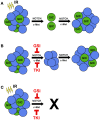Ionizing radiation in glioblastoma initiating cells
- PMID: 23579692
- PMCID: PMC3619126
- DOI: 10.3389/fonc.2013.00074
Ionizing radiation in glioblastoma initiating cells
Abstract
Glioblastoma (GBM) is the most common primary malignant brain tumor in adults with a median survival of 12-15 months with treatment consisting of surgical resection followed by ionizing radiation (IR) and chemotherapy. Even aggressive treatment is often palliative due to near universal recurrence. Therapeutic resistance has been linked to a subpopulation of GBM cells with stem cell-like properties termed GBM initiating cells (GICs). Recent efforts have focused on elucidating resistance mechanisms activated in GICs in response to IR. Among these, GICs preferentially activate the DNA damage response (DDR) to result in a faster rate of double-strand break (DSB) repair induced by IR as compared to the bulk tumor cells. IR also activates NOTCH and the hepatic growth factor (HGF) receptor, c-MET, signaling cascades that play critical roles in promoting proliferation, invasion, and resistance to apoptosis. These pathways are preferentially activated in GICs and represent targets for pharmacologic intervention. While IR provides the benefit of improved survival, it paradoxically promotes selection of more malignant cellular phenotypes of GBM. As reviewed here, finding effective combinations of radiation and molecular inhibitors to target GICs and non-GICs is essential for the development of more effective therapies.
Keywords: DNA damage response; NOTCH; c-MET; glioma initiating cells; radiation.
Figures

Similar articles
-
Knockdown of the DNA-dependent protein kinase catalytic subunit radiosensitizes glioma-initiating cells by inducing autophagy.Brain Res. 2011 Jan 31;1371:7-15. doi: 10.1016/j.brainres.2010.11.044. Epub 2010 Nov 23. Brain Res. 2011. PMID: 21108935
-
miR-33a promotes glioma-initiating cell self-renewal via PKA and NOTCH pathways.J Clin Invest. 2014 Oct;124(10):4489-502. doi: 10.1172/JCI75284. Epub 2014 Sep 9. J Clin Invest. 2014. PMID: 25202981 Free PMC article.
-
Spatial Heterogeneity of Invading Glioblastoma Cells Regulated by Paracrine Factors.Tissue Eng Part A. 2022 Jul;28(13-14):573-585. doi: 10.1089/ten.TEA.2021.0168. Epub 2022 Jan 24. Tissue Eng Part A. 2022. PMID: 34841881
-
Mechanisms regulating radiosensitivity of glioma stem cells.Neoplasma. 2017;64(5):655-665. doi: 10.4149/neo_2017_502. Neoplasma. 2017. PMID: 28592117 Review.
-
Role and Therapeutic Targeting of the HGF/MET Pathway in Glioblastoma.Cancers (Basel). 2017 Jul 11;9(7):87. doi: 10.3390/cancers9070087. Cancers (Basel). 2017. PMID: 28696366 Free PMC article. Review.
Cited by
-
MicroRNA‑200a suppresses migration and invasion and enhances the radiosensitivity of NSCLC cells by inhibiting the HGF/c‑Met signaling pathway.Oncol Rep. 2019 Mar;41(3):1497-1508. doi: 10.3892/or.2018.6925. Epub 2018 Dec 12. Oncol Rep. 2019. PMID: 30569179 Free PMC article.
-
A multiplexed bioluminescent reporter for sensitive and non-invasive tracking of DNA double strand break repair dynamics in vitro and in vivo.Nucleic Acids Res. 2020 Sep 25;48(17):e100. doi: 10.1093/nar/gkaa669. Nucleic Acids Res. 2020. PMID: 32797168 Free PMC article.
-
Bip inhibition in glioma stem cells promotes radiation-induced immunogenic cell death.Cell Death Dis. 2020 Sep 22;11(9):786. doi: 10.1038/s41419-020-03000-z. Cell Death Dis. 2020. PMID: 32963254 Free PMC article.
-
Long Noncoding RNA WT1-AS Inhibit Cell Malignancy via miR-494-3p in Glioma.Technol Cancer Res Treat. 2020 Jan-Dec;19:1533033820919759. doi: 10.1177/1533033820919759. Technol Cancer Res Treat. 2020. PMID: 32419643 Free PMC article.
-
Extraneural Metastasis of Primary Glioma Occurring in a Setting of Occupational Ionizing Radiation Exposure.Case Rep Neurol Med. 2019 Jun 13;2019:1748739. doi: 10.1155/2019/1748739. eCollection 2019. Case Rep Neurol Med. 2019. PMID: 31312534 Free PMC article.
References
-
- Abounader R., Ranganathan S., Lal B., Fielding K., Book A., Dietz H., et al. (1999). Reversion of human glioblastoma malignancy by U1 small nuclear RNA/ribozyme targeting of scatter factor/hepatocyte growth factor and c-met expression. J. Natl. Cancer Inst. 91, 1548–155610.1093/jnci/91.18.1548 - DOI - PubMed
-
- Amgen. (2012). Analysis of Rilotumumab (AMG 102) Data Identifies a Potential Predictive Biomarker for Patients with Gastric or Gastroesophageal Cancer [Press Release]. Available at: http://www.amgen.com/media/media_pr_detail.jsp?releaseID=1696824
Grants and funding
LinkOut - more resources
Full Text Sources
Other Literature Sources
Research Materials
Miscellaneous

